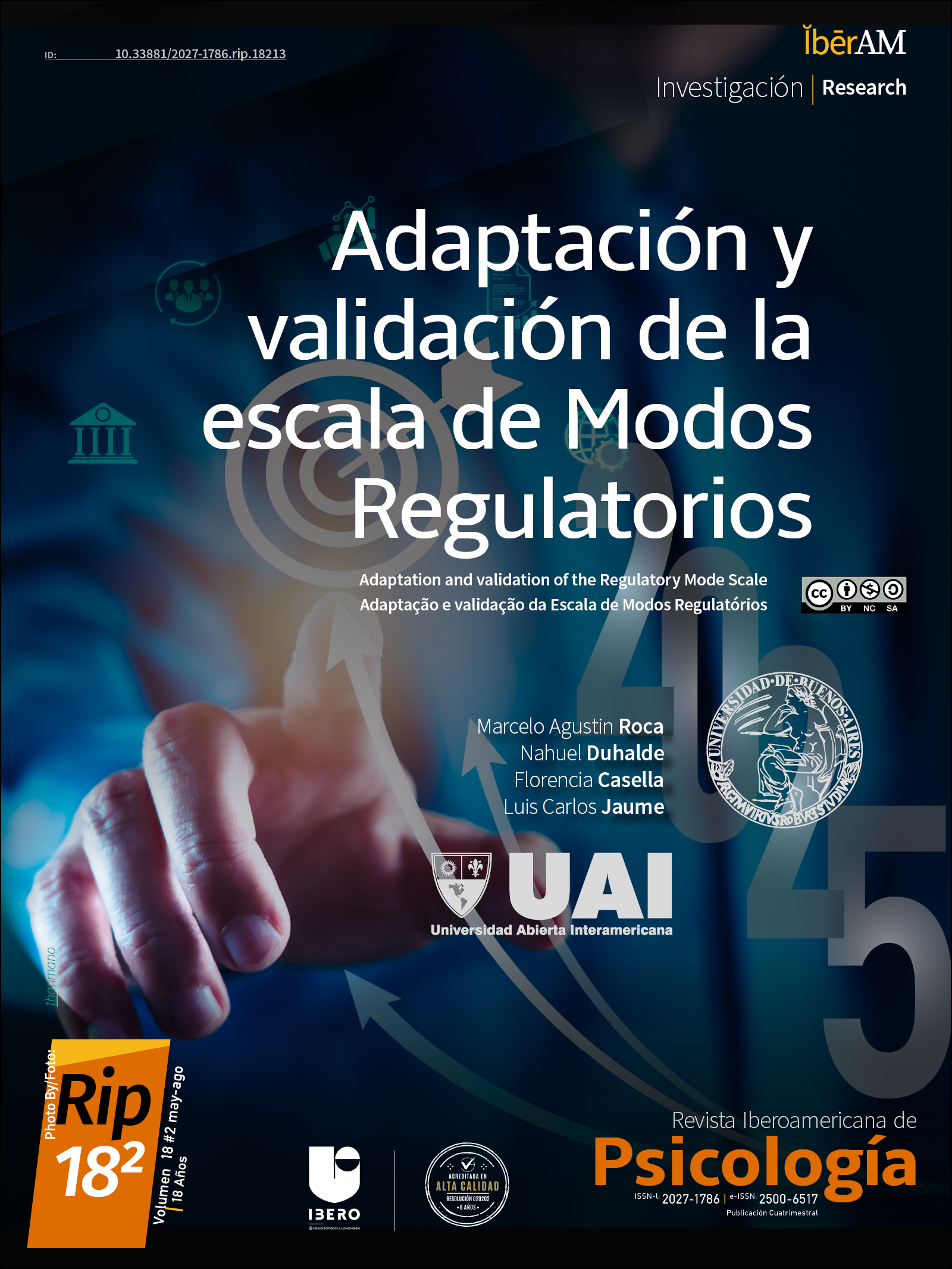Adaptation and Validation of the Regulatory Modes Scale
Adaptación y validación de la escala de Modos Regulatorios
Main Article Content
Regulatory modes can be defined as the different ways of acting to achieve a certain goal. There are two functionally independent types of regulatory modes: locomotion and assessment. Locomotion refers to the ability to initiate and sustain movement toward a goal, while assessment focuses on the critical comparison of alternatives to determine the best option. Although many authors have explored this topic, there is a lack of research addressing regulatory modes and the validation of their scales in Latin American countries. The present study aims to adapt the instrument and provide evidence of its construct, criterion validity, and reliability in the Argentine context. A sample of 230 Argentine individuals was used for the pilot study, and 713 for the main study. An Exploratory Factor Analysis was conducted with the pilot sample, while a Confirmatory Factor Analysis was performed with the main study sample. The results led to the elimination of some items, yielding good psychometric properties. In the end, a five-item “locomotion” scale and a five-item “assessment” scale were established, both showing satisfactory reliability and a positive association between them. This work provides an initial approach to this topic in Argentina, facilitating the potential use of these scales in future studies.
Downloads
Publication Facts
Reviewer profiles N/A
Author statements
- Academic society
- Bogotá: Corporación Universitaria Iberoamericana
- Publisher
- Bogotá: Corporación Universitaria Iberoamericana
Article Details
Ballester Esteve, I., Fernández Piqueras, R., & Parra-Camacho, D. (2021). Adaptación y validación de una escala para la evaluación del desempeño profesional del entrenador de fútbol en base a su formación permanente, nivel de TIC y autoevaluación. Retos: Nuevas tendencias en Educación Física, Deportes y Recreación, 40, 272-280. https://doi.org/10.47197/retos.v1i40.83157
Choy, E. E. H., & Cheung, H. (2018). Time perspective, control, and affect mediate the relation between regulatory mode and procrastination. PLOS ONE, 13(12). https://doi.org/10.1371/journal.pone.0207912
Chen, F. F. (2007). Sensitivity of Goodness of Fit Indexes to Lack of Measurement Invariance. Structural Equation Modeling: A Multidisciplinary Journal, 14(3), 464–504. https://doi.org/10.1080/10705510701301834
Cheung, G. W., & Rensvold, R. B. (2002). Evaluating goodness-of-fit indexes for testing measurement invariance. Structural equation modeling, 9(2), 233-255. https://doi.org/10.1207/S15328007SEM0902_5
Da Silva, J. D., Faia, V. D. S., & Vieira, V. A. (2016). The negative effects of experience and control on salesperson's performance/Os efeitos negativos da experiencia e do controle no desempenho do vendedor/Los efectos negativos de la experiencia y del control en el desempeno del vendedor. RAE, 56(6), 626-641. https://periodicos.fgv.br/rae/article/view/64792
DeVellis, R. F. (2017). Scale Development: Theory and Applications (4ta. Ed.). Sage Publications. https://collegepublishing.sagepub.com/products/scale-development-5-269114
Dominguez-Lara S. (2018). Reliability and ordinal alpha. Fiabilidad y alfa ordinal. Actas urológicas españolas, 42(2), 140–141. https://doi.org/10.1016/j.acuro.2017.07.002
Elosua, P. (2005). Evaluación progresiva de la invarianza factorial entre las versiones original y adaptada de una escala de autoconcepto. Psicothema, 17(2), 356-362. https://reunido.uniovi.es/index.php/PST/article/view/8281
Higgins, E. T., Kruglanski, A. W., & Pierro, A. (2003). Regulatory mode: Locomotion and assessment as distinct orientations. Advances in Experimental Social Psychology, 35, 293–344. http://dx.doi.org/10.1016/S0065-2601(03)01005-0
Hinton, P. (2014). SPSS Explained. Milton Park: Routledge. https://doi.org/10.4324/9781315797298
Hu, L. T., & Bentler, P. M. (1999). Cutoff criteria for fit in-dexes in covariance structure analysis: Conventional criteria versus new alternatives. Structural Equation Modeling: A Multidisciplinary Journal, 6(1), 1-5. https://doi.org/10.1080/10705519909540118
Jaume, L. C., Schetsche, C., Roca, M. A., & Quattrocchi, P. (2022). Factor Structure and Internal Consistency on a Reduced Version of the Revised Test of Need for Cognitive Closure. Frontiers in Psychology, 12, 813115-813115. https://doi.org/10.3389/fpsyg.2021.813115
Jaume, L. C., & Roca, M. A. (2020). La evaluación del perdón, los modos regulatorios y la necesidad de cierre cognitivo: construyendo una agenda de investigación. Subjetividad y Procesos Cognitivos, 24(1), 1-21. http://dspace.uces.edu.ar:8180/xmlui/handle/123456789/5366
Jordan Muiños, F. M. (2021). Valor de corte de los índices de ajuste en el análisis factorial confirmatorio. Psocial, 7(1), 66-71. http://portal.amelica.org/ameli/journal/123/1232225009/
Kruglanski, A. W., Dechesne, M., Orehek, E., & Pierro, A. (2009). Three decades of lay epistemics: The why, how, and who of knowledge formation. European Review of Social Psychology, 20(1), 146-191. https://doi.org/10.1080/10463280902860037
Kruglanski, A. W., Pierro, A., Mannetti, L., & Higgins, T. E. (2013). The distinct psychologies of “looking” and “leaping”: Assessment and locomotion as the springs of action. Social and Personality Psychology Compass, 7(2), 79-92. https://doi.org/10.1111/spc3.12015
Kruglanski, A. W., Thompson, E. P., Higgins, E. T., Atash, M. N., Pierro, A., Shah, J. Y., & Spiegel, S. (2000). To "do the right thing" or to "just do it": Locomotion and assessment as distinct self-regulatory imperatives. Journal of Personality and Social Psychology, 79(5), 793–815. https://doi.org/10.1037/0022-3514.79.5.793
Leys, C., Delacre, M., Mora, Y. L., Lakens, D., & Ley, C. (2019). How to Classify, Detect, and Manage Univariate and Multivariate Outliers, With Emphasis on Pre-Registration. International Review of Social Psychology, 32(1): 5, 1–10. https://doi.org/10.5334/irsp.289
Liu, H., Rubenstein A. L., Li G., Liu, Z., Zhan, X, & Xiong, J. (2022) A time to consider, a time to deliver: The independent and interactive effects of regulatory mode on innovative work behavior. Journal of product innovation management, 39, 202–221. https://doi.org/10.1111/jpim.12614
Mardia, K. V. (1970). Measures of multivariate skewness and kurtosis with applications. Biometrika, 57, 519–530. https://doi.org/10.1093/biomet/57.3.519
Montero, I., & León, O. G. (2007). A guide for naming research studies in Psychology. International Journal of Clinical and Health Psychology, 7(3), 847-862. https://psycnet.apa.org/record/2007-14302-016
Morris, R. & Pinelli, F. (2022) The cognitive, neural, and social aspects of regulatory mode and its implications on well-being and decision-making. Journal of European Psychology Students, 13(1), 78–92. https://doi.org/10.5334/jeps.568/
Pica, G., Jaume, L.C. & Pierro, A. (2020). Let’s go forward, I forgive you! On motivational correlates of interpersonal forgiveness. Current Psychol, 41, 6786–6794. https://doi.org/10.1007/s12144-020-01180-7
Pica, G., Mallia, L., Pierro, A., Alivernini, F., Borellini, V., & Lucidi, F. (2019). How stressful is retirement! Antecedents of stress linked to athletes’ career termination. Journal of Applied Social Psychology, 49(8), 488-497. https://doi.org/10.1111/jasp.12599
Pierro, A., Chernikova, M., Lo Destro, C., Higgins, E. T., & Kruglanski, A. W. (2018). Assessment and locomotion conjunction: How looking complements leaping…but not always. Advances in Experimental Social Psychology, 58, 243–299. https://doi.org/10.1016/bs.aesp.2018.02.001
Pierro, A., & Kruglanski, A. W. (2005). Revised Need for Cognitive Closure Scale. (Unpublished Manuscript). La Sapienza: Università di Roma. https://creativeengagementlab.com/sites/default/files/2024-01/Need-For-Closure-Scale-short-version.pdf
Scholl, A., Wenzler, M., Ellemers, N., Scheepers, D., & Sassenberg, K. (2021). Just do it or do it right? How regulatory mode relates to perceived responsibility and opportunity in collaborations. Personality and Individual Differences, 176, 110776. https://doi.org/10.1016/j.paid.2021.110776
Smith, G. T., McCarthy, D. M., and Anderson, K. G. (2000). On the sins of short-form development. Psychol. Assess. 12, 102–111 https://doi.org/10.1037/1040-3590.12.1.10
R Core Team (2023). R: A language and environment for statistical computing [Software informático]. https://www.R-project.org/
Ugarte Ontiveros, D., & Aparicio de Guzman, R. M. (2020). Técnicas robustas y no robustas para identificar outliers en el análisis de regresión. Investigación & Desarrollo, 20(2), 41-56. https://doi.org/10.23881/idupbo.020.2-3e
Tabachnick, B. G., & Fidell, L. S. (2012). Using multivariate statistics (6a Ed.). Pearson
Vazeou-Nieuwenhuis, A., Orehek, E., & Scheier, M. F. (2017). The meaning of action: Do self-regulatory processes contribute to a purposeful life? Personality and Individual Differences, 116, 115–122. https://doi.org/10.1016/j.paid.2017.04.040
Webb, C. E., Coleman, P. T., Rossignac-Milon, M., Tomasulo, S.J., & Higgins, E. T. (2017). Moving on or digging deeper: Regulatory mode and interpersonal conflict resolution. Journal of Personality and Social Psychology, 112(4), 621–641. https://doi.org/10.1037/pspp0000131
Webster, D. M., & Kruglanski, A. W. (1994). Individual differences in need for cognitive closure. Journal of personality and social psychology, 67(6), 1049. https://doi.org/10.1037/0022-3514.67.6.1049












